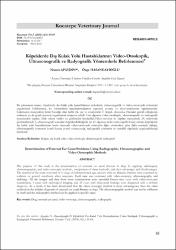| dc.contributor.author | Apaydın, Nusret | |
| dc.contributor.author | Hasandayıoğlu, Özge | |
| dc.date.accessioned | 2019-01-30T11:31:20Z | |
| dc.date.available | 2019-01-30T11:31:20Z | |
| dc.date.issued | 2018 | |
| dc.identifier.citation | Apaydın N. Hasandayıoğlu Ö. Köpeklerde Dış Kulak Yolu Hastalıklarının Video-Otoskopik, Ultrasonografik ve Radyografik Yöntemlerle Belirlenmesi. Kocatepe Vet J. (2018) 11(1): 63-69.. | en_US |
| dc.identifier.uri | http://dergipark.gov.tr/download/article-file/402061 | |
| dc.identifier.uri | http://hdl.handle.net/11630/5287 | |
| dc.description.abstract | Bu çalışmanın amacı; köpeklerde dış kulak yolu hastalıklarının radyolojik, ultrasonografik ve video-otoskopik yöntemler uygulanarak belirlenmesi, bu yöntemlerin karşılaştırmalarının yapılarak avantaj ve dezavantajlarının saptanmasıdır. Çalışmanın materyalini; kulak hastalığı olan farklı ırk, yaş ve cinsiyetteki 31 köpek oluşturdu. Hastalar gerekli olduğunda sedasyon ya da genel anestezi uygulanarak muayene edildi. Her olgunun video-otoskopik, ultrasonografik ve radyografik muayeneleri yapıldı. Elde edilen veriler ve görüntüler kaydedildi.Video-otoskop ile yapılan muayenede 29, radyolojik görüntülemede 3, ultrasonografi sonuçları değerlendirildiğinde ise 25 olgunun kesin tanısı yapıldı.Sonuç olarak; köpeklerde dış kulak yolu hastalıklarının kesin tanısında video-otoskopik yöntemin diğer yöntemlere göre daha avantajlı olduğu, ultrasonografik yöntemin kendi başına yeterli olamayacağı, radyografik yöntemin ise spesifik olgularda uygulanabileceği belirlendi. | en_US |
| dc.description.abstract | The purpose of this study is the determination of external ear canal diseases in dogs by applying radiological, ultrasonographic, and video-otoscopic methods, comparison of these methods, and their advantages and disadvantages. The material of the study consisted of 31 dogs of different breed, age, and sex with ear diseases. Patients were examined by sedation or general anesthesia when necessary. Each case was examined with video-otoscopy, ultrasonography and radiology. All the images and data from these examinations were recorded.Twenty-nine cases with video-otoscopic examination, 3 cases with radiological imaging, and 25 cases with ultrasound findings were diagnosed with a definite diagnosis. As a result, it has been determined that the video-otoscopic method is more advantageous than the other methods in the definite diagnosis of external ear canal diseases in dogs. The ultrasonographic method can not be sufficient by itself and the radiographic method can be applied in specific cases. | |
| dc.language.iso | tur | en_US |
| dc.identifier.doi | 10.5578/kvj.66405 | en_US |
| dc.rights | info:eu-repo/semantics/openAccess | en_US |
| dc.subject | Köpek | en_US |
| dc.subject | Dış Kulak Yolu | |
| dc.subject | Video-Otoskopi | |
| dc.subject | Ultrasonografi | |
| dc.subject | Radyografi | |
| dc.subject | Dog | |
| dc.subject | External Ear Cana | |
| dc.subject | Video-Otoscopy | |
| dc.subject | Otoskopi | |
| dc.subject | Ultrasonography | |
| dc.subject | Radiography | |
| dc.subject | Otoskopy | |
| dc.title | Köpeklerde dış kulak yolu hastalıklarının video-otoskopik, ultrasonografik ve radyografik yöntemlerle belirlenmesi | en_US |
| dc.title.alternative | Determination of external ear canal problems using radiographic, ultrasonographic and video-otoscophic methods | en_US |
| dc.type | article | en_US |
| dc.relation.journal | Kocatepe Veteriner Dergisi | en_US |
| dc.department | Kayseri Erciyes Üniversitesi, Veteriner Fakültesi | en_US |
| dc.identifier.volume | 11 | en_US |
| dc.identifier.startpage | 63 | en_US |
| dc.identifier.endpage | 69 | en_US |
| dc.identifier.issue | 1 | en_US |
| dc.relation.publicationcategory | Makale - Ulusal Hakemli Dergi - Kurum Yayını | en_US |



















